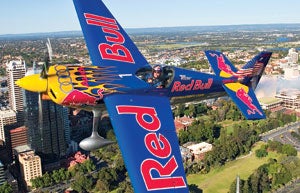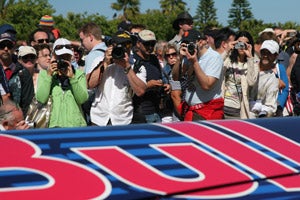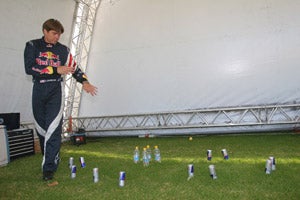 |
| Kirby Chambliss flies his Edge 540 over downtown Perth, Australia, but he relies on crew members for support to compete successfully in the air races. |
At the closing ceremonies of each Red Bull Air Race, there’s always a jubilant atmosphere. Pilots douse each other in champagne, confetti fills the air, everyone cheers and countless autographs are signed. The racers have worked hard and deserve such a moment. But away from the fanfare, crew members have just as much reason to celebrate. Mechanics, ferry pilots and managers have given their all to help the pilots succeed and have also earned the right to be proud. “Our pilots represent us,” says Lance Winter, mechanic for the 2006 series winner, Kirby Chambliss. “If they do well, we have done well.”
I joined Kirby’s team at the tenth and final race of 2007 in Perth, Australia, where more than 350,000 spectators oohed and aahed as 13 pilots flew highly modified Edge 540s, Extra 300s and an MX2 through a course of inflatable pylons over the picturesque Swan River. My host, Red Bull Flight Communications Manager Maddy Stephens, indicated that a huge behind-the-scenes effort is really what makes each race a success: “Each team requires a high level of expertise from its crew, and it takes more than 300 full-time Red Bull Air Race operations crew to bring it all together.” Qualifying day provided a good opportunity to hang out at the hangars and see what goes on away from the limelight.
 |
| What’s He Thinking? |
| ”My crew understands that if they make a mistake, it may cost a life.” —Kirby Chambliss |
| We asked Kirby Chambliss what goes through his mind from before he steps into the plane until he finishes the race.
I come from a competition aerobatics background, where visualizing an unknown sequence on the ground is very important because you don’t get to practice it beforehand. It’s the same with the race; I try to visualize the track in my mind before I get into the airplane. Once I’m strapped in, I’m thinking about the wind, and I’ll read velocity and direction from the lines on the water. Can I pull more on this gate because of a headwind? As I dive into the track, what’s the fastest way to get from this gate to that gate? I always try to just barely make it. During finals, I fly completely flat out. I have to because it’ll make the difference between first or second. After a race, when I’m sitting up there in the holding pattern, I can usually tell if I’ve had a good run. But in San Diego, I was sure I had it in the bag. I had barely made everything. When they called out my time versus Paul Bonhomme’s, he had knocked me out by a half second. I was really surprised. I hated my results this year. I was on the podium four times, but none of them were the first spot. During the previous year, I won half of the races and was on the podium for all but one. 2007 was a bummer. Do I blame myself? Sure, my flying could have been better during some of the races. But as the saying goes, it doesn’t matter if you’re the best jockey out there, if you’re on a slow horse, you can keep beating it but it won’t go faster. Going forward, we’re making some changes to the airplane, but we don’t know what everyone else is doing. Only time will tell, and at the first race, we’ll find out what was a good change and what wasn’t. I have a really good crew, so if we’ve done all the right things, we’re going to be really competitive. We’re looking forward to a good season in 2008. |
 It was immediately evident that Red Bull Air Race crew members are given an enormous amount of responsibility, which begins well before the racing does. To transport airplanes between sites, they’re disassembled, loaded into shipping containers and trucked to hangars at a temporary runway—in Perth, a riverside park was transformed into an immaculately manicured grass strip that any pilot would drool over—where they’re reassembled and test-flown. “It’s difficult, dirty work, but it has to be done properly,” says Len Rulason, an A&P mechanic and aerobatic pilot who crewed for Kirby in 2006 and British racer Steve Jones in 2007. “Steve typically has five days of obligation per Red Bull Air Race; I usually do 10.”
It was immediately evident that Red Bull Air Race crew members are given an enormous amount of responsibility, which begins well before the racing does. To transport airplanes between sites, they’re disassembled, loaded into shipping containers and trucked to hangars at a temporary runway—in Perth, a riverside park was transformed into an immaculately manicured grass strip that any pilot would drool over—where they’re reassembled and test-flown. “It’s difficult, dirty work, but it has to be done properly,” says Len Rulason, an A&P mechanic and aerobatic pilot who crewed for Kirby in 2006 and British racer Steve Jones in 2007. “Steve typically has five days of obligation per Red Bull Air Race; I usually do 10.”
 |
| Frank Versteegh races knife-edge in his Edge 540 through a challenging course of inflatable pylons, reaching speeds of up to 250 mph (above). Pilots Nicolas Ivanoff and Peter Besenyei celebrate Mike Mangold’s 2007 series victory (below). |
Jason Resop, Kirby’s Crew Chief of four years, will test-fly the Edge 540 if Kirby isn’t on the scene yet. “My job is to make sure everything is 100% okay and that the airplane is always ready to fly,” he explains. “If something breaks, it has to be fixed right away.” The international Red Bull Air Race circuit has a following that brings NASCAR to mind, and pilots can be easily distracted by sponsor obligations, media and zealous fans (6,000 of which lined up on Qualifying Day for the public pit lane walk—one named her newborn in honor of Kirby, another asked him to pose with his favorite stuffed kangaroo). “I need to concentrate on flying, and the last thing I want to worry about is if the airplane is in good shape,” said Kirby before I watch him beeline to the airplane without a walk-around. “My preflight checklist only has one item: open the canopy. My crew understands that if they make a mistake, it may cost a life.”
 |
| 2007 Series Results |
| Top Five of Thirteen |
| 1. Mike Mangold USA |
| 2. Paul Bonhomme GBR |
| 3. Peter Besenyei HUN |
| 4. Kirby Chambliss USA |
| 5. Steve Jones GBR |
 |
| The Red Bull Air Race world series has a strong international following, and more than 350,000 spectators attended the 2007 championship race in Perth. |
And that’s why a pilot’s support team is essential. In fact, every team in 2008 will include one or two A&P mechanics plus a team coordinator to help ease the load and take racing to the next level. Chandoline Byrnes, Kirby’s team coordinator, oversees the team’s travel schedule and onsite logistics, acting as a liaison with Red Bull Air Race. “Before every race,” she says, “there’s a tremendous amount of logistics and planning involved to make sure everything runs smoothly with the team.”
A fraction of a second makes all the difference, so teams aim to reduce aircraft weight and increase power as much as possible. “Between flights, I try to get the motor as cool as I can by facing it into the wind or by using fans,” explains Lance. “We also monitor the smoke system, and I try to keep the hole in the exhaust pipe small. We want to have enough smoke to run the race, but we don’t want more than necessary because it’ll add weight. We tape up gaps between panels and on flight surfaces to reduce drag and use lighter batteries, alternators and prop governors. We even advance the timing a little bit.”
 |
|
| 2008 Race Locations | |
| Check www.redbullairrace.com for exact dates and cities | |
| United Arab Emirates United States Sweden Netherlands United Kingdom Hungary Portugal Spain Australia |
|
But they won’t tell me all their tricks. Over the years, the races have become more competitive, and pilots more secretive. “I no longer pull the cowling off the airplane when other teams are around,” admits Jason. “The pilots are all friends, but when it comes to racing, they get quiet during finals.” During training sessions, he acts as a spotter, watching Kirby fly to see where they can squeak out another half second, and tracking others to see if there’s anything new up their sleeves.
A similar friend-competitor dynamic exists between crew members as well. “As mechanics, we’ll help another pilot out if they need it,” concedes Lance. “We want them to win on skill, not because a mechanical problem grounded someone else.” At the race in Istanbul, the wingtip on U.S. pilot Mike Mangold’s airplane failed. Len, who was crewing for Steve Jones, helped with repairs, and Mike won the race. “We always try to assist, but at some point in the future, I suspect the race officials won’t want us to do that,” predicts Len. “We’re all there to win, and it may come to the point where if someone else has a problem, then that’s their tough luck.”
During the off season, crew members handle media obligations, ferry flights, maintenance work and test modifications. Both of Kirby’s airplanes were required at an air show in San Antonio, Texas, but there was only one Jason. So he ferried the first one, returned on an airliner, and then ferried the other one—all in one day. Kirby enjoys this ultimate autopilot: “I tell the airplane to go from point A to point B, and it does. I don’t want to ferry; I just want to get home. But I wish I’d had a job like that when I was Jason’s age.” Jason’s sentiments exactly: “Ferry flights are an awesome opportunity to fly the Edge. The coolest flight was from Istanbul to Interlaken. We flew over places I’d never even dreamed of. What I would ultimately love to do is race, and the flying experiences I get are worth more than any pay I could ever receive.”
| Day In The Life | ||
| We trailed Jason Resop, Crew Chief for Kirby Chambliss, to see what a typical race day entails for a crew member. | ||
| 0800: Report to the Temporary Runway; begin prepping the airplane | 1430: Assist with media interviews and demo flights | |
| 0930: Pilot briefing with Red Bull Air Race officials | 1600: Take care of any problems with the airplane | |
| 1100: Preflight checklist | 1700: Tie down plane for the evening | |
| 1300: First round of racing—last-minute tweaks | 1730: Catch a quick dinner | |
| 1310: Spot competitors | 1830: Review videos of the day’s flights | |
| 1320: Debriefing with Kirby | 2000: In bed ready for the next day | |
| 1330: Tweak airplane; cool down engine | ||
Check www.redbullairrace.com for updates as the competition steps up a notch.
What can fans look forward to from their favorite team? I asked Lance, but I suspect all teams would have the same answer: “First place!”
Photo Gallery:
 |
 |
 |
 |
 |
 |
 |
 |
 |
 |
 |
 |




